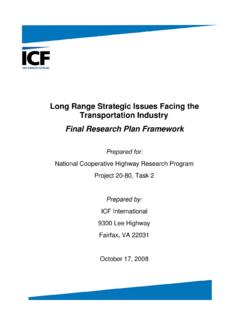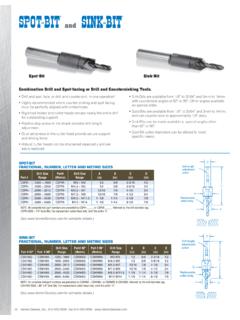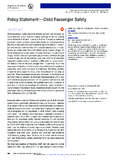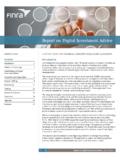Transcription of The Mauritian Textile and Clothing Industry: Facing the ...
1 1 The Mauritian Textile and Clothing industry : Facing the Challenges Associatedwith GlobalisationS. Rosunee, Department of Textile Technology, Faculty of Engineering, Universityof MauritiusAbstractThe Maurtian economy grew rapidly during the early 1990 s as the country embracedtrade liberalisation and became increasingly integrated in the world economy. For mostof the 1990 s, annual growth was of the order of 5% to 6%, mainly due to the strongexport performance of the Textile and Clothing industry aided by preferential access to theEuropean Union. Despite this remarkable achievement, Mauritius now faces aneconomic slowdown due to a number of factors, both internal and early 2000, the country was poised to take advantage of the Africa Growth andOpportunity Act (AGOA) but up to now Mauritian manufacturers have been unable tomake a significant impact in the huge American market. The Textile and apparel quotasystem will be eliminated on January 1, 2005 as agreed by the Uruguay Round of tradetalks.
2 Currently, Mauritian manufacturers are witnessing the adverse effects ofcompetition from low cost producers on the domestic industry with quotas; what will bethe outcome without quotas? This paper also outlines the strategies being implemented tosustain the industry s IntroductionOver the past three decades, the Textile and Clothing industry has been an engine ofeconomic growth, generated thousands of new jobs and propelled this island-nationtowards prosperity. The industry accounts for 12% of gross domestic product (GDP),employs nearly 77,000 people out of a workforce of 550,000 and generates about 65% ofexport earnings (USD billion). Employment in this sector increased by about 13%from 1995 to 1999 but it has now stabilised mainly through gains in productivity [1].With trade liberalisation, the Mauritian Textile and Clothing industry is now faced with anumber of short and medium-term challenges, on both the internal and external relate mainly to elimination of trade preferences, exchange rate fluctuations,relatively slow pace of restructuration and diversification, increased competition fromlow-cost manufacturers, rising costs of air and sea freight, and low penetration of with growing unemployment (about 10%, March 2004), accelerated economicgrowth to create jobs and improve standard of living is on top of government s agenda[2].
3 textiles and apparel will remain one of Mauritius s key manufacturing sectors but anew mindset is critical for the renewed health of the industry . The sector has no optionbut to invest in product and design innovation through research, new technology, highlyskilled workers and successful marketing. How we innovate, how we use materials andmachines in new ways and anticipate consumer demands will dictate the future of theMauritian Textile and Clothing industry . Table 1 illustrates the importance of textiles andclothing manufacture in a number of developing 1: Percentage of Total Export Earnings in textiles and Clothing (Source, WTO)Percentage of Total Export EarningsCountryTextiles (T) Clothing (C)T+CGDP perCapita (USD)Bangladesh97584343 Pakistan492372436 Mauritius564693,773 Sri Lanka45054862 Turkey1425392,999 Tunisia240422,058 Morocco232341,115 Madagascar29130243 Haiti22830497 India141428453On the regional level, Mauritius has done well with the share of manufacturing valueadded (MVA) in the GDP being about 19% while for most African countries MVAremains below the minimum 16% required on an ongoing basis for sustainabledevelopment.
4 Moreover, the African continent has seen its GDP per capita fall between1990 and 2000, from USD 755 to USD 673 [3].Source: UNIDO International Yearbook of Industrial Statistics, 2002, Vienna, AustriaFigure 1: Share of Manufacturing Value Added (MVA) in GDP of some ACP and EUCountries, 1990 and 2000 (as %, 1990 prices)Mauritius, therefore, urgently needs to translate this competitive advantage intosubstantial inflow of foreign investment and skilled job creation. In terms of trade,government policy is to defend acquired markets, as well as to vigorously seek newmarkets. It seeks to capitalise on all opportunities opened to it (such as through the AfricaGrowth and Opportunity Act), and has been active in pressing for the opening up ofregional and sub-regional groups which it sees as providing opportunities for greater3trade and investment. In addition, government, through appropriate legislation, hasimproved Mauritius s reputation for (homeland) security and institutional fairness amongpotential productive sectors of the Mauritian economy have undergone drastic change over theyears and the role of the secondary and tertiary sectors has grown at the expense of theprimary sector, Table 2 Sectoral Composition of GDP (%) : ACP-EU CourierThe change in the structure of the economy has been partially reflected in employmentpatterns.
5 In 1998 the primary sector absorbed about 9% of the labour force, compared in 1970. The secondary sector which became significant during that periodabsorbed about 33% of labour in 1998 as against in 1982. The tertiary sector,however, has continued to employ the major proportion of total labour force, with anaverage of over the same period [4]. Table 3 shows the real growth rates of themain sectors and sub-sectors of the Mauritian 3 Real Growth Rates (%)RealGrowthRates (%) * (*) Exceptional figures due to drought in 1999 Despite the volatility of textiles and Clothing , Mauritius has been quite successful inpreserving market share. Unfortunately, the removal of preferential access to traditionalmarkets threatens to undermine the industry and thus limit Mauritius s growth. Therestructuring of the industry is high on government agenda and a number of policiesincluding diversification are being natural disadvantage Facing small island developing states (SIDS) is their small size,small size of their domestic markets, limited natural resources, limited human capitalwhich in turn negatively impact on foreign direct investment (FDI).
6 FDI, following thetrend over the last decade, has been little interested in the production of low value-addedgoods. The thrust of FDI, as in India, China or Mexico, has gone towards the production4of high-tech products either for export or domestic consumption, taking advantage oftheir huge domestic markets, which SIDS will never have. The drought of FDI in thetextile and Clothing sector in Mauritius may be attributed to two main reasons; small sizeof the domestic market and low pace of diversification into higher value-added activitieswithin the sector. Though Mauritius is investor-friendly and enjoys a number ofcompetitive advantages (social, cultural, political, environmental), the trickle of FDI hasproved difficult to Globalisation: Optimism and UncertaintyWhile the abolition of import restrictions on Textile and Clothing may benefit consumersin industrialised countries, most developing nations, big or small, harbour strongreservations.
7 They point out that global economic integration favours the already wealthyand hurt the poor. Ironically, in 1994, when the World Trade Organisation (WTO) wascreated, almost all member nations assumed that the end of Textile quotas, part of richcountry trade reform, would create more jobs across the board. In 2004, this enthusiasmis shared only by big, low-cost producers while relatively small producers are beingsqueezed of globalisation in developing countries argue that it is an economicopportunity as it will usher in more trade and prosperity. However, there are pertinentquestions that need to be answered. How do we ensure a level playing field or fair competition when countries withdiametrically opposite profiles are vying for the same markets? Is it possible to create trading conditions so that emerging economies can competeinternationally? Is globalisation not excluding smaller producers from the international market?
8 Will industrialised countries not place trade barriers of a different kind? Mauritian manufacturers maintain that the future of the sector is threatened by exportinggiants like China and India. During the first quarter of 2003, Chinese Clothing exports tothe US increased by 27%, with quotas and duties still in place. What will be the growthof Chinese exports without quotas? The WTO has predicted that after abolition of quotasChina may capture 50% of the American Clothing market and 29% of the EU s [5].Similarly, Vietnam alone can rival the amount of goods exported to North America fromall sub-Saharan African countries combined even with duties. The American CentralBank has estimated that the Chinese yuan is approximately 40-50% undervalued withrespect to the US dollar. To add to the currency advantage, more than half of Textile millsand more than a quarter of apparel makers are state-owned.
9 Even though these companiesregularly run at a loss, the Chinese government subsidises their output to gain marketshare around the world. In addition, there is provision for an export tax rebate [6].The over-concentration of Mauritian Textile and Clothing exports towards the EuropeanUnion (65% in 2000) has accentuated the vulnerability of the sector in the face ofglobalisation. In 2000-2001, Textile and Clothing exporters incurred serious financiallosses resulting from a declining Euro and an appreciating Dollar (most inputs importedby the sector are paid in US dollars, whereas the enterprises are paid for their goods5largely in Euro). Fortunately, the recent rise of the Euro against the US dollar is earningsignificant windfall 2: EU-Mauritius Clothing Trade (million Euros)At the Doha Round, small economies like Mauritius tried to procure a differential systemof market access. However, a final decision is still pending.
10 Mauritius also demandedassistance to help strengthen production and export capacities. Meanwhile, at the nationallevel, urgent measures that include diversification of products and markets andproductivity improvements have been Regional Trade and CooperationThough trade with other Indian Ocean and Southern African countries (other than SouthAfrica) is still quite limited, Mauritius is keen to increase levels of trade and investmentregionally and regional co-operation is an increasingly important feature of foreignpolicy. In the wake of globalization, regional cooperation is deemed to be inevitable andirreversible for Mauritius to overcome the constraints of size and lack of is an active member of a number of Indian Ocean and Southern Africanregional organisations, including: COMESA (the Common Market for Eastern and Southern Africa); IOC (Indian Ocean Commission); SADC (Southern African Development Community); IORA (Indian Ocean Rim Association).







